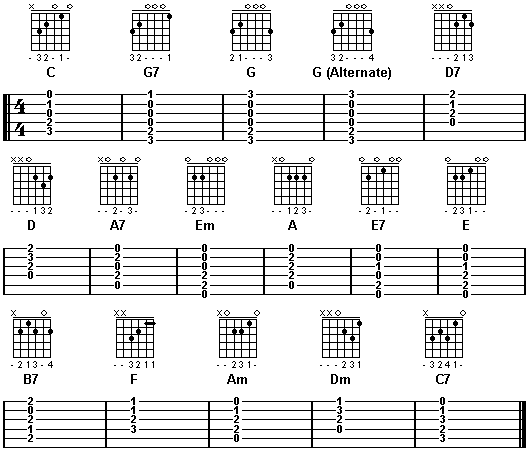Playing chords is one of the most important parts of playing the guitar. In the coming sections, there will be simple songs with tablature for the melodies. Above the tablature, you will see chord names that go with these songs. Play the chords, followed by the tablature. When practising chords, make sure you are relaxed and don't push your arm into your body. Keep your thumb behind the neck and don't let it bend backwards. One way to make sure you are in position is to hold your thumb out like you are hitchhiking, then place it behind the middle of the guitar neck. Now bring your fingers into position over the fretboard. Proper thumb placement will ensure that your fingers don't accidently touch the wrong string.
|
Basic Chords |
Note finger usage below each chord chart. the "x" means don't strum that string. The "o" means play the string open. Some of these chords may be hard to play at first, but try your best and it will get easier!

At first, your fingertips may hurt, but don't worry, if you practise everyday, callouses will develop and it will become easier. Remember to keep your fingernails short on your left hand (if you are right handed) because if they are too long, it makes it more difficult to press down on the string. Don't strum too fast when practising chords. It is better to strum slowly so you can hear every note. If all the notes don't sound right, try moving your fingers up or down the fretboard a little until they make the proper sound. Generally, your fingertips should be just behind the fret, but not on the fret. It varies from chord to chord however.
One of the biggest challenges as a beginner is to be able to change from chord to chord quickly. This usually takes longer to learn than the actual chords themselves. That best way to get better is to visualize what fingers have to change to make the next chord.
Examples:
Play the various chords and try to note the simularities and differences. This will help speed up your chord changes. Remember it is better to play slowly with no breaks in between each chord than it is to play fast with a large break between the chords!
Here are some common chord progressions that you can try to get used to playing them. Strum each chord slowly 4 times and repeat:
| Progression 1 | G - Em - C - D |
| Progression 2 | C - Am - F - G |
| Progression 3 | D - C - G |
| Progression 4 | E - A - D - A |
| Progression 5 | Am - G - F - G |
| Progression 6 | C - F - G7 |
| Progression 7 | D - G - A7 |
| Progression 8 | E - A - B7 |
| Progression 9 | G - C - D7 |
| Progression 10 | A - D - E7 |
| Progression 11 | Dm - C - G |
Picture View of Common Chords
Click on thumbnail for larger view: